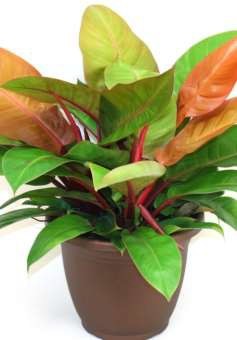Prince of Orange Philodendron

by Chris Stulhsatz
The Philodendron 'Prince of Orange' is a houseplant that can be tough to find but would bring beautiful fall color to your houseplant collection! It’s a popular and attractive cultivar of the Philodendron species. It is known for its vibrant, eye- catching foliage and is a favorite among indoor plant enthusiasts. Here are some key characteristics and care tips for the Philodendron 'Prince of Orange':
- Foliage: The 'Prince of Orange' gets its name from the striking color of its new When they emerge, they are a brilliant orange or copper color, which gradually darkens to a rich green as they mature. The leaves are typically heart-shaped and have a glossy appearance.
- Growth Habit: This Philodendron is a relatively compact plant, making it suitable for smaller It has a bushy growth habit and can be trained to climb if provided with a support structure.
- Light Requirements: 'Prince of Orange' Philodendrons thrive in bright, indirect light. They can tolerate some morning or late afternoon sun but should be protected from intense, direct sunlight, which can scorch the
- Temperature: This plant prefers warm temperatures and should be kept above 50°F (10°C). It's not suitable for outdoor planting in areas with cold
- Watering: Like many Philodendron varieties, 'Prince of Orange' prefers to be kept evenly moist but not waterlogged. Water when the top inch of the soil feels dry, and reduce watering in the winter when growth slows
- Humidity: While not as demanding as some tropical plants, Philodendron 'Prince of Orange' benefits from increased humidity. Regular misting or placing a humidity tray nearby can help create a more suitable
- Soil: Use a well-draining potting mix with good organic A mix designed for aroids or a general-purpose houseplant soil can work well.
- Fertilization: During the growing season (spring and summer), feed your 'Prince of Orange' with a balanced, diluted liquid fertilizer every 4-6 Reduce or eliminate fertilization in the winter when growth slows down.
- Pruning: Regular pruning can help maintain a bushy and compact You can also propagate new plants from cuttings.
- Toxicity: Like many Philodendrons, the 'Prince of Orange' is toxic if ingested, so it should be kept away from pets and small children.
This Philodendron cultivar is prized for its striking foliage and ease of care, making it a popular choice for indoor plant enthusiasts. With the right conditions and care, it can add a burst of color to your home or office space!

Have questions? Contact our office where our Horticulture Extension Agent will assist you with questions.
Phone: (316) 321-9660
Email: callae@ksu.edu